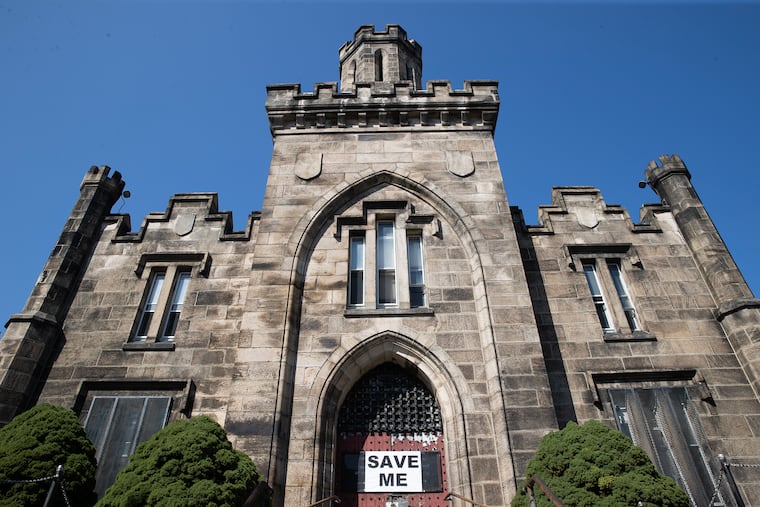At Norristown forum, calls to preserve historic county prison others view as relic of racism
Supporters of preserving the former Montgomery County Prison in Norristown heard a panel of experts, including an advocate for penal reform, speak against demolition of the Airy Street landmark.

Saving the former Montgomery County prison from demolition could be a way to “acknowledge the history of incarceration” and its disparate impact on poor communities, a national penal reform advocate told an audience in Norristown Wednesday.
“As you all continue on this journey, hopefully successfully, to preserve the structure and adaptively reuse it for community benefit, it’s an opportunity to be part of a national conversation,” said Nicole Porter, a senior director at the Sentencing Project in Washington.
Porter was one of four speakers featured during a public forum at Theatre Horizon in downtown Norristown. The event, which drew about 60 people, was sponsored by Friends of the Prison.
The imposing Gothic landmark, designed by Napoleon LeBrun, the architect of the Academy of Music and the Cathedral Basilica of SS. Peter and Paul in Center City Philadelphia, is beloved by local residents, who have signed petitions and joined in the effort to preserve it.
But it has also been described by some county and borough officials who seek its demolition as a symbol of injustice.
Montgomery County plans to spend $1.1 million to tear down the block-long Airy Street prison. It has been vacant since the 1980s and is widely considered historically and architecturally significant.
» READ MORE: In Norristown, some view a long-vacant prison as an architectural gem. Others see historic injustice.
In August, Kenneth E. Lawrence, the chairperson and first Black member of the Montgomery County Commission, released a statement saying the county is “not prepared to ask taxpayers to spend millions of dollars to preserve a monument to a system of incarceration that disproportionately imprisoned people of color ... we refuse to invest in celebrating that legacy.”
» READ MORE: Kenneth E. Lawrence: The former Montgomery County prison is a monument to injustice | Opinion
Commissioner Jamila Winder and Norristown borough council president Thomas Lepera also have spoken out in favor of demolition. The borough’s Historical Architectural Review Board, an advisory body, has yet to make a recommendation, but the Norristown council — which has the final authority over whether to issue a demolition permit — could take up the matter at its meeting on Nov. 8.
Porter did not cite officials by name at Wednesday’s forum. She said that if “status quo power brokers” are using concerns about mass incarceration “as a pretext” to support demolition in spite of community support for preservation, “I question their motivation and the framing of their views.”
“If they have a critique of mass incarceration, how do those views show up in [their] other work? Or is [what they are saying] just rhetoric?”
In a statement Thursday, Lawrence said: “Our policies match our rhetoric. Justice reform has been one of the county’s highest priorities, and since 2018, our reform efforts have safely reduced our prison population by 50%.
“We believe county tax dollars should be spent on keeping people out of the current prison rather than preserving the old one.”
Lepera said by phone Thursday that he’s “just happy someone thinks someone from Norristown is a power broker,” adding, “my record in Norristown speaks for itself.”
Besides Porter, the other featured speakers at the forum were Paul Steinke, executive director of the Preservation Alliance for Greater Philadelphia; Todd Poole, founder of 4Ward Planning, in Philadelphia; and longtime Norristown architect Douglas Seiler.
Collectively, the speakers questioned why the county seemed in a rush to dispose of the building, at considerable public expense, despite no current analyses of the redevelopment opportunities — and potential public funding sources — for repurposing the one-acre complex.
“Has the county ever offered the property for sale? It could be leveraged for community revitalization,” said Steinke, whose organization headlined the prison battle in its August “Advocacy Update” and urged readers to sign a petition against demolition.
They also said Philly’s Eastern State Penitentiary provides a model, and attests to the potential, for the Airy Street prison to become not only a destination, but a place to educate the public about the societal impact of incarceration.
Seiler, who led earlier efforts to find a new use for the Airy Street prison, said Wednesday that one possibility would be to preserve the castle-like 1851 front portion, but not the entirety, of the structure.
» READ MORE: Turn the Norristown prison into a museum of justice | Opinion
The latest campaign features T-shirts, posters, and public events along with social media, including a Change.org petition, and has inspired locals such as Peggy Becker-Dellisanti, a volunteer at Wednesday’s event.
“I grew up in Philly across from Eastern State, so I know what [preserving] Eastern State has done for my old neighborhood,” she said.
Calling the Airy Street edifice “a beautiful gem,” Becker-Dellisanti said the prison could be repurposed as a music venue and museum.
“It’s quite possibly the most important historic building in Norristown. It really is a community-defining landmark,” said Aaron Wunsch, an associate professor at the University of Pennsylvania’s Weitzman School of Design, who attended the event.
“There are plenty of examples of prisons that have been well-adapted for reuse. And if the concern is mass incarceration, tearing down a building that was never part of that is not an effective way” to address the issue, he said.